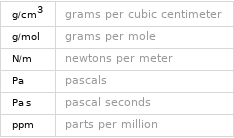Input interpretation

3 mol of acetone
Basic properties for 3 mol
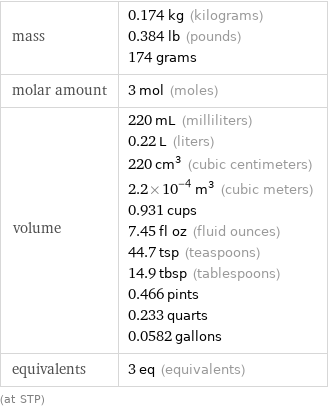
mass | 0.174 kg (kilograms) 0.384 lb (pounds) 174 grams molar amount | 3 mol (moles) volume | 220 mL (milliliters) 0.22 L (liters) 220 cm^3 (cubic centimeters) 2.2×10^-4 m^3 (cubic meters) 0.931 cups 7.45 fl oz (fluid ounces) 44.7 tsp (teaspoons) 14.9 tbsp (tablespoons) 0.466 pints 0.233 quarts 0.0582 gallons equivalents | 3 eq (equivalents) (at STP)
Thermodynamic properties for 3 mol
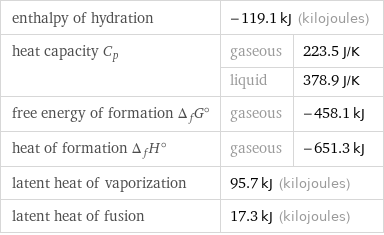
enthalpy of hydration | -119.1 kJ (kilojoules) | heat capacity C_p | gaseous | 223.5 J/K | liquid | 378.9 J/K free energy of formation Δ_fG° | gaseous | -458.1 kJ heat of formation Δ_fH° | gaseous | -651.3 kJ latent heat of vaporization | 95.7 kJ (kilojoules) | latent heat of fusion | 17.3 kJ (kilojoules) |
Units

Energy vs. temperature for 3 mol
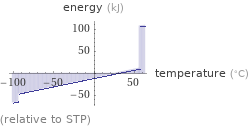
(relative to STP)
Units

Phase change energies for 3 mol from 25 °C
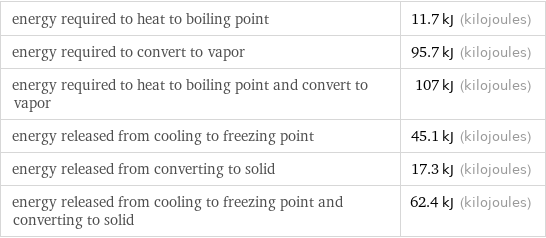
energy required to heat to boiling point | 11.7 kJ (kilojoules) energy required to convert to vapor | 95.7 kJ (kilojoules) energy required to heat to boiling point and convert to vapor | 107 kJ (kilojoules) energy released from cooling to freezing point | 45.1 kJ (kilojoules) energy released from converting to solid | 17.3 kJ (kilojoules) energy released from cooling to freezing point and converting to solid | 62.4 kJ (kilojoules)
Corresponding quantities

sphere radius | 3.747 cm (centimeters) side of a cube | 6.039 cm (centimeters)
Mass composition for 3 mol

C (carbon) | 108.100 g (62.0%) H (hydrogen) | 18.140 g (10.4%) O (oxygen) | 48.000 g (27.5%)

Mass composition for 3 mol
Lewis structure
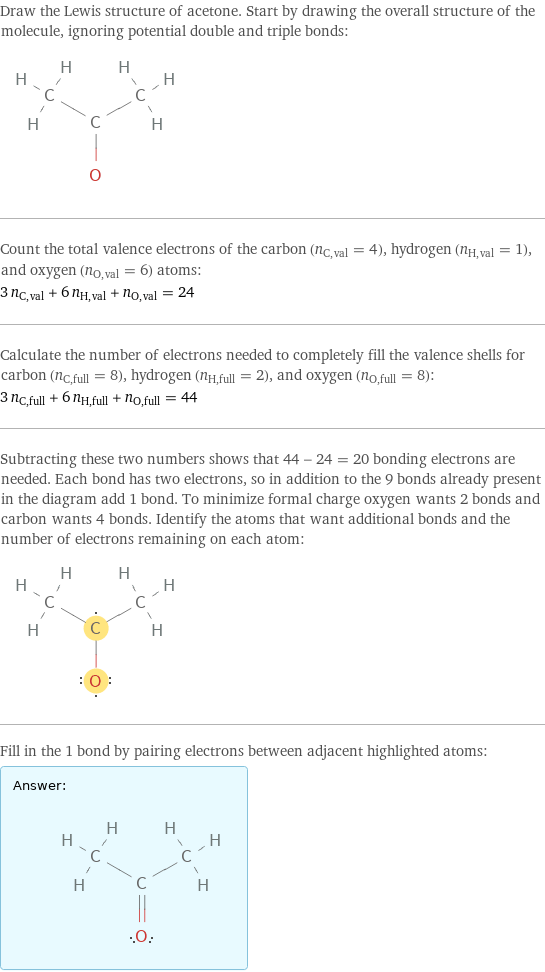
Draw the Lewis structure of acetone. Start by drawing the overall structure of the molecule, ignoring potential double and triple bonds: Count the total valence electrons of the carbon (n_C, val = 4), hydrogen (n_H, val = 1), and oxygen (n_O, val = 6) atoms: 3 n_C, val + 6 n_H, val + n_O, val = 24 Calculate the number of electrons needed to completely fill the valence shells for carbon (n_C, full = 8), hydrogen (n_H, full = 2), and oxygen (n_O, full = 8): 3 n_C, full + 6 n_H, full + n_O, full = 44 Subtracting these two numbers shows that 44 - 24 = 20 bonding electrons are needed. Each bond has two electrons, so in addition to the 9 bonds already present in the diagram add 1 bond. To minimize formal charge oxygen wants 2 bonds and carbon wants 4 bonds. Identify the atoms that want additional bonds and the number of electrons remaining on each atom: Fill in the 1 bond by pairing electrons between adjacent highlighted atoms: Answer: | |
Chemical names and formulas
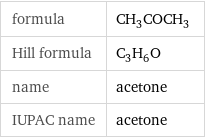
formula | CH_3COCH_3 Hill formula | C_3H_6O name | acetone IUPAC name | acetone
Substance properties

molar mass | 58.08 g/mol phase | liquid (at STP) melting point | -94 °C boiling point | 56 °C (measured at 101308 Pa) density | 0.791 g/cm^3 solubility in water | miscible surface tension | 0.0228 N/m dynamic viscosity | 3.06×10^-4 Pa s (at 25 °C) odor | mint-like odor threshold | 13 ppm
Units
